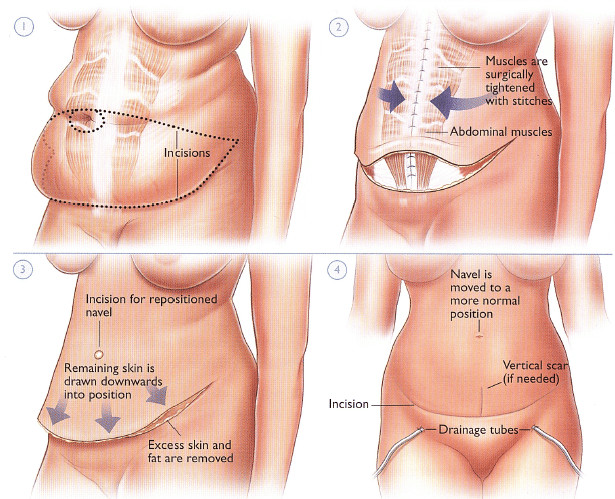A tummy tuck, also known as an Abdominoplasty, is an extensive cosmetic surgery procedure for removing excess skin and fat (may involve liposuction) from the abdominal area and in the process tightening the abdominal muscles. This type of plastic surgery helps to improve body contouring around the recipient’s waistline, leaving them with a flatter, more toned stomach. It’s a popular cosmetic procedure due to its ability to transform the recipient’s shape.
Recovery is often a concern for many patients who undertake the cosmetic surgery. It is important to understand that recovery times can vary significantly among individuals, and while following these tips may aid in your recovery, it’s essential to adhere to the advice and guidelines provided by your healthcare professional for post-surgery care.
What is involved in a tummy tuck procedure?

A tummy tuck procedure involves the removal of excess skin and fat from the abdomen while tightening the abdominal muscles. Depending on the patient, the cosmetic surgery generally takes between two to five hours for a complete Abdominoplasty.
While under general anaesthetic, the doctor creates an incision extending from each hip, just above the pubic area. The scar from this incision is designed to remain hidden underneath bikinis or underwear. A second incision will be made to free the navel from surrounding tissue. Patients undergoing a partial Abdominoplasty will have a much shorter incision and the navel will not be moved.
Once the incisions have been made, the skin is separated from the abdominal wall all the way up to the patient’s ribs. This large skin flap reveals the vertical muscles which are tightened by pulling them closer together and securing them in place with stitches. The result is a narrowed waistline and firmer abdominal walls.
The skin flap is then stretched down and any excess skin is removed before the incision is stitched together. Liposuction may be performed also. A new opening is created for a naval and again, stitched in place. Dressings will be applied to the area and temporary tubes may be inserted into the incision to drain excess fluid away from the surgical site.
How to prepare for your tummy tuck surgery
Preparing for your tummy tuck surgery is just as important as your post-surgery recovery period. For optimal healing and results your doctor will go over everything you need to know prior to your surgical procedure. It’s important to carefully follow all your doctor’s instructions, including:
- Smoking
Patients will be asked to quit smoking at least two weeks before surgery and will be advised not to resume smoking until two weeks after the tummy tuck procedure. Smoking during the recovery process increases the chances of complications and side-effects, slowing down healing time. - Dieting
Drastic dieting and weight loss is not advised prior to your surgical procedure. A healthy, well-balanced diet will adequately prepare you for the cosmetic surgery and improve wound healing. - Medication
Patients should disclose to their doctor ahead of time any medication or supplements they may be taking. This includes prescription drugs and herbal medications. Patients may be advised to stop some medications prior to the surgery to avoid complications and side-effects, and give recipients the opportunity for a faster recovery process after their full or mini tummy tuck.
What is recovery process from a tummy tuck really like?
Depending on the extent of the Abdominoplasty, patients may be required to stay in a hospital for two to three days.
Whether you’ve had a mini tummy tuck or a full mommy makeover, for the first few days after the procedure your abdomen will most likely be swollen and slightly bruised. This will dissipate over the initial weeks following surgery. Patients will experience some pain and discomfort which can be controlled by pain medication.
Tummy tuck recipients may also experience some numbness around the abdominal area. This is due to some of the nerves being cut as the doctor gets to the abdominal muscles. This diminished sensation often returns over the course of a few months.
Patients who have had drains inserted into the incision sites will need to be empty them daily post-surgery. These will likely be removed about one week to ten days after the tummy tuck procedure.
Since some of the excess skin has been removed from the abdomen, the body needs time to adjust, making it difficult to stand up straight during the first week of recovery. Patients won’t necessarily be bedridden but may find it more comfortable sitting or lying down initially. It is advised for patients to walk around post-tummy tuck to prevent blood clots from forming and reduce swelling.
Tips to speed up the recovery from tummy tuck
- Look after yourself prior to the surgery
Your lifestyle can affect your ability to recover from your cosmetic surgery procedure. Patients in good physical condition and with strong abdominal muscles experience a quicker recovery. Adopting a healthy diet and getting plenty of physical activity prior to your surgery can also speed up your body’s ability to heal. - Take your medication
You’ll be prescribed pain medication following your tummy tuck procedure. After the first 48 hours over-the-counter pain medication may be sufficient. It is important to take your medication before the pain becomes unbearable. Patients often find they will use less medication if they take it on time, rather than waiting until the pain becomes severe. Healing is also often faster as pain can interfere with the body’s healing process. It is also important to take the antibiotics prescribed to you post tummy tuck procedure and on time. This not only aids in a faster recovery and wound healing, but also reduces the possibility of infection. - Get adequate rest
One key tummy tuck recovery tip is to allow your body plenty of time to recuperate. The healing process is accelerated during sleep, so get plenty of it. - Wear your abdominal support garment (also known as compression garment)
While compression garments are not that attractive, they do play a crucial role in your healing process and the end result of the tummy tuck. Compression garments act to control the swelling and provide your abdomen with support. They also help with the healing of the abdominal scars. - Keep hydrated
Drinking plenty of water during your recovery period after the tummy tuck procedure will help prevent bloating and keep your regular. Pain medications can cause constipation as well as make you feel bloated and sometimes cause intestinal cramps. Staying well-hydrated will ensure your digestive tract is in working order and help flush out any residual medications. - Exercise
Exercising post-tummy tuck is advised to help you heal better. It is important you speak with your doctor regarding when the best time to resume any strenuous activity. Those who have never worked out before are encourage to start exercising slowly and carefully. This will help to reduce swelling, lower the risk of developing a blood clot and aids to tone muscles.
Recovery from a tummy tuck procedure varies greatly among individuals and is influenced by various factors, including the person’s overall health, the specifics of the procedure, and adherence to post-operative instructions. It’s crucial to follow your doctor’s guidance closely and attend all scheduled follow-up appointments to ensure a safe and effective recovery process.
Patients need to expect the initial tummy tuck recovery phase to take a few weeks before your abdomen will begin to feel more comfortable. So don’t expect to be up and getting back to your routine immediately after your surgery. A faster recovery is going to ultimately depend on how well you look after yourself following the tummy tuck procedure.
Want to know more? Read our:






